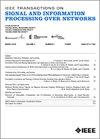Latent Graphical Models of Multivariate Count Time Series
IF 3
3区 计算机科学
Q2 ENGINEERING, ELECTRICAL & ELECTRONIC
IEEE Transactions on Signal and Information Processing over Networks
Pub Date : 2025-09-01
DOI:10.1109/TSIPN.2025.3604659
引用次数: 0
Abstract
Conventional mathematical models of infectious diseases frequently overlook the spatial spread of the disease concentrating only on local transmission. However, spatial propagation of various diseases have been noted between geographical regions mainly due to the movement of infectious individuals from one region to another. In this work, we propose generalized linear models to study the graph of dependencies between multiple infection count time series from neighbouring regions. Due to the inherent theoretical and computational difficulties in inferring traditional partial correlation and causality graphs for such multiple count time series data, weakened concepts of correlation and causality of appropriate latent variables are introduced to simplify computation. In order to estimate these latent graphs with tunable sparsity, a novel Monte Carlo expectation and maximization algorithm is used to iteratively maximize an appropriate regularized likelihood function, and asymptotic convergence is established. In addition to simulated data, the algorithm is applied on observed weekly dengue disease counts from each region of an Indian city. The interdependence of various regions in the proliferation of the disease is characterized by the edges of the inferred latent graphs. It is observed that some regions act as epicentres of dengue spread even though their disease counts are relatively low.多元计数时间序列的潜在图形模型
传染病的传统数学模型往往忽视了只关注局部传播的疾病的空间传播。然而,已注意到各种疾病在地理区域之间的空间传播,这主要是由于传染性个体从一个区域移动到另一个区域。在这项工作中,我们提出了广义线性模型来研究来自邻近地区的多个感染计数时间序列之间的依赖关系图。由于对这类多次计数的时间序列数据进行传统的偏相关图和因果图的推导存在理论和计算上的困难,为了简化计算,引入了适当潜变量的弱化相关和因果关系的概念。为了估计具有可调稀疏性的潜在图,提出了一种新的蒙特卡罗期望和最大化算法,迭代地最大化一个合适的正则似然函数,并建立了渐近收敛性。除了模拟数据外,该算法还应用于从印度城市的每个地区观察到的每周登革热疾病计数。疾病扩散过程中各个区域的相互依赖性由推断的潜图的边缘表征。可以观察到,一些地区是登革热传播的中心,尽管它们的疾病数量相对较低。
本文章由计算机程序翻译,如有差异,请以英文原文为准。
求助全文
约1分钟内获得全文
求助全文
来源期刊

IEEE Transactions on Signal and Information Processing over Networks
Computer Science-Computer Networks and Communications
CiteScore
5.80
自引率
12.50%
发文量
56
期刊介绍:
The IEEE Transactions on Signal and Information Processing over Networks publishes high-quality papers that extend the classical notions of processing of signals defined over vector spaces (e.g. time and space) to processing of signals and information (data) defined over networks, potentially dynamically varying. In signal processing over networks, the topology of the network may define structural relationships in the data, or may constrain processing of the data. Topics include distributed algorithms for filtering, detection, estimation, adaptation and learning, model selection, data fusion, and diffusion or evolution of information over such networks, and applications of distributed signal processing.
 求助内容:
求助内容: 应助结果提醒方式:
应助结果提醒方式:


